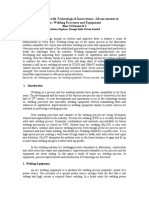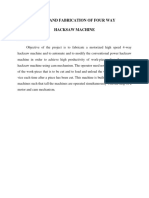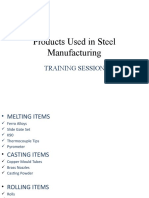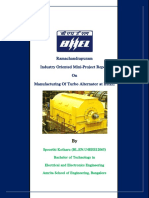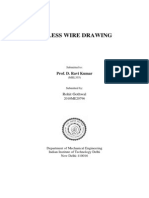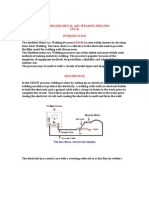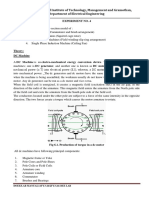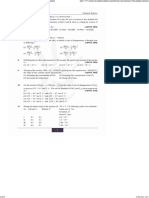Experimental and Analysis of Welding Electrode Wire Straightening and Cutting Machine
Experimental and Analysis of Welding Electrode Wire Straightening and Cutting Machine
Uploaded by
Tarig shgool HagarCopyright:
Available Formats
Experimental and Analysis of Welding Electrode Wire Straightening and Cutting Machine
Experimental and Analysis of Welding Electrode Wire Straightening and Cutting Machine
Uploaded by
Tarig shgool HagarOriginal Title
Copyright
Available Formats
Share this document
Did you find this document useful?
Is this content inappropriate?
Copyright:
Available Formats
Experimental and Analysis of Welding Electrode Wire Straightening and Cutting Machine
Experimental and Analysis of Welding Electrode Wire Straightening and Cutting Machine
Uploaded by
Tarig shgool HagarCopyright:
Available Formats
See discussions, stats, and author profiles for this publication at: https://www.researchgate.
net/publication/281270726
Experimental and Analysis of Welding Electrode Wire Straightening and
Cutting Machine
Article · January 2015
CITATIONS READS
0 4,541
2 authors, including:
Babu Bhaskaran
AMRITA COLLEGE OF ENGINEERING AND TECHNOLOGY NAGARCOIL
60 PUBLICATIONS 77 CITATIONS
SEE PROFILE
Some of the authors of this publication are also working on these related projects:
DESIGN AND DEVELOPMENT AUTOMATIC SEWAGE CLEANING MACHINE View project
AIR POLLUTION'S ENVIRONMENTAL AND HEALTH EFFECTS: A REVIEW View project
All content following this page was uploaded by Babu Bhaskaran on 26 August 2015.
The user has requested enhancement of the downloaded file.
International Journal of Latest Trends in Engineering and Technology (IJLTET)
Experimental and Analysis of Welding
Electrode Wire Straightening and Cutting
Machine
B.Babu
Assistant professor, Kongunadu College of engineering and technology, Thottiam, Trichy, Tamilnadu, india
S.K.Karthikeyan
Assistant professor, Kongunadu College of engineering and technology, Thottiam, Trichy, Tamilnadu, india
V.Selvam
Assistant professor, Kongunadu College of engineering and technology, Thottiam, Trichy, Tamilnadu, india
Abstract - A cutting machine for manufacturing wire-like rods, particularly for electrodes for welding. It comprises at
least one advancement assembly adapted to receive and produce the advancement of a wire- like product at a preset
advancement speed from an inlet to at least one cutting assembly which is adapted to cut the wire- like product into rods
of preset lengths. The cutting assembly being interposed, along the advancement line of the wire- like product between the
advancement assembly and at least one assembly for collecting the rods the cutting assembly comprising at least two
rotating shears of the motorized type with rotation axes which are parallel and mutually opposite with respect to the
advancement line of the wire-like product. Synchronization means being further comprised which are associated with the
cutting assembly and with the advancement assembly for the adjustment of the tangential speed of the reciprocating
shears. This project deals with increasing the production rate of the machine from 100rods/minute to 200rods/minute and
reducing the down time of production.
I. INTRODUCTION
Wire Straightening and Cutting Machines (WSCM) are widely used to extend wires from a roll or coil in
order to straight and to cut. These machines are offered with extensive features requiring diverse applications. Some
machines are configured for straightening and cutting all kinds of cold drawing wires and other nonferrous metal
wires. They may cut the wire as per requirements in the required dimension and thereafter, work continuously.
These machines are complied with three different processes such as feeding, straightening and cutting off.
These machines are available with various features such as different diameter size wires for straightening, different
cutting lengths and standard multi-power motor for both straightening and cutting of wires. The straightening is
carried out in order to ensure the straightness of a rod work piece as well as to redistribute or reduce the residual
stress in the material. The straightening is carried out in two ways either by means of using killing rollers or by
means of using the spinner arrangement. From this two techniques the killing rollers arrangement is generally
preferred when the length of the wire is high and it generally uses a reverse bending process. The object is to cause
the wire to reversibly flex beyond its elastic limit as it traverses through the straightening rolls. The spinner
arrangement is preferred for short length wires. The apparatus comprising a rotary member having a passage through
which the material is guided. The removal of the twist enables the cutting head to cut the wire exactly to the
predefined length.
II. DESCRIPTION OF THE MACHINE
2.1 PROPERTIES OF WELDING ELECTRODE
Welding electrode are used in welding various metals for chemical and allied industries, construction of
steel structures such as bridges, factory sheds, in the manufacturing of ships and engineering alloys. Mild steel is
welded by the electrodes to a maximum among all metals and Alloys. Therefore M.S. Welding electrode is the most
widely used core wire.
Welding electrodes comprise basically of steel core wire and coating ingredients or flux mild steel, nickel,
Nickel-copper, Nickel irons are also used for welding in fertilizer, chemical and surgical instrument making
industry. In this fabrication process used mild steel welding electrode rod of grade C15.
Vol. 5 Issue 1 January 2015 333 ISSN: 2278-621X
International Journal of Latest Trends in Engineering and Technology (IJLTET)
Electrode Mild steel
Grade C15
Diameter 2.5,3.15,4,5mm
Length of electrode 350mm &450mm
Table No: 1 Specification of electrode wire
2.2 PREVIOUSLY EXISTING MACHINE
The previously existing Electrode wire straightening and cutting machine is capable of cutting and
straightening 100pieces/minute. The feed rate of the rollers is around 35m/minute. The power to the roller, spinner
and the cutting block is provided by a 5hp motor. The main objective of the project is to increase the production rate
from 100pieces/minute to 200pieces/minute. So the feed rate of the roller should be increased to double the time i.e.
around 70m/minute by making necessary modifications to the motor unit and the cutting block unit.
Motor specification 5hp,3
Speed 2880rpm
Motor type Foot mounted.
Table No: 2 Specification of the existing machine
2.3 THE PROCESS CARRIED OUT IN THE CUTTING MACHINE
Among the methods for production of rod-like electrodes for welding, it is known to use cutting machines
that are adapted to cut a wire like product into rods of standardized lengths ranging from 350mm to 450mm and with
a diameter comprised of 2mm to 6mm.The known type of cutting machine comprise an advancement assembly,
generally of the type with pairs of motorized rollers with circumferential grooves of suitable diameter in which the
wire like product is accommodated. In this manner, the wire-like products acquires speed and pushed into the
straightening assembly or spinner consists of five dies which is used to straighten the wire effectively along its
length. Then the straightened wire is again fed into another pair of advancement assembly which feds the wire into
the cutting unit provided with the cutting shears provided with cutting tool made of tungsten carbide. The power to
the reciprocating shear is provided by the flywheel and cam arrangement is powered by 1hp motor and driven by a
V-belt. The measuring unit consists of stopper provided at the predefined length supported by a spring loaded
arrangement.
2.4 COMPONENTS OF A WELDING ELECTRODE CUTTING MACHINE
The main components of the cutting machine comprises mainly of,
1. Pay off stand
2. Advancement feed roller assembly
3. Straightening unit or spinner assembly
4. Wire cutting unit or scaling bar
5. Wire measuring unit & Wire collecting unit.
2.4.1 PAY OFF STAND
The electrode wire is rolled around this layoff stand. The layoff stand is a provided with a rotating body placed
over the fixed base that provides constant feed to the machine. The base should be made wide enough that
withstands vibration and force due to the pulling force provided by the roller.
Fig. No 2.1 Payoff stand
Vol. 5 Issue 1 January 2015 334 ISSN: 2278-621X
International Journal of Latest Trends in Engineering and Technology (IJLTET)
Fig. No 2.2 Layout of electrode wire straightening and cutting unit
2.4.2 FEED ROLLER ASSEMBLY
The main purpose of the feed roller assembly is to provide the necessary pulling force for the electrode wire from
the layoff stand into the straightening unit or spinner and from the straightening unit after straightening is carried out
.For this purpose two pairs of rollers are used. The roller is provided with groove which matches with the various
diameter of the wire. The power to the roller is provided by chain and sprocket assembly through the shaft.
Fig. No 2.3 Feed roller and Feed roller housing arrangement
The shaft is connected to directly to a gear which is again is meshed with another gear. The two gears
provide the rotation motion of the roller. The rollers are placed one above another and the electrode wire travels on
the meshing space between the two rollers. The necessary tension to the electrode wire is provided by adjusting the
space between the two rollers through a spring loaded rotating hand lever arrangement.
SPECIFICATION OF THE ROLLER
Number of roller = 4
Diameter of the roller = 75mm
Diameter of the shaft =25mm
2.4.3 SPINNER ASSEMBLY OR STRAIGHTENING UNIT
Wire straightening apparatus is used to straighten wire, supplied in a rolled or coiled stock. The removal of
the twist enables the cutting head to cut the wire exactly to the predefined length. The apparatus comprising a rotary
member having a passage through which the material is guided. The material is deflected away from the axis of
rotation. The first portion will be curved and is directed away from the side axis. The second portion which is
substantially parallel with the axis of rotation is less tightly curved than the first portion. The arrangement being
such that the rotation of rotary member about its axis straightens material fed through.
The second portion of the path enables the first portion to have a small radius of curvature. It is believed
that this combination of relatively small radius of curvature and a small displacement from the axis gives rise to the
improved performance compared with known type of wire straightening apparatus.
The spinner will be powered by a 7.5hp motor with the aid of flat belt assembly. The speed of the spinner
will be 8784rpm.
Vol. 5 Issue 1 January 2015 335 ISSN: 2278-621X
International Journal of Latest Trends in Engineering and Technology (IJLTET)
Fig. No 2.4 Spinner arrangements
The passage is provided for fixed diameter of wire which causes the downtime while we are using different
diameter wires since we want to replace the spinner every time we are using wires of different diameter. So, in order
to reduce the downtime a dovetail is made on the spinner base and to the fixed base of the machine. Therefore it
provides an easy way of replacement of the spinner unit by reducing the time for replacing and for again tightening
the bolts. This may damage the screw threads and requires periodic maintenance.
2.4.4 CUTTING UNIT
The cutting unit is the one in which the cutting action on the electrode wire is provided by the reciprocating shears.
The power to the reciprocating shear is provided by the cam arrangement which in turn is connected to the shaft.
Flywheels are provided on both the ends of the shaft. The power to the shaft is transmitted through the V-belt
arrangement powered by 1hp motor.
Motor 1hp
Power rating 3 ,415V,50Hz
Speed 1440rpm
Type Foot mounted
Belt type V-belt
Table No: 3 Cutting unit motor specification
The shaft is inserted into the cutter housing by a special type of bushing known as ultra bushing. The ultra
bush is a cylindrical bush capable of absorbing axial, radial and torsional movements.
The main advantage of the ultra bush is its maintenance-free, prevents sound transmission, adjustments of
manufacturing tolerances and as a coupling elements in drives.
The eccentric rotation of the cam arrangement provides the reciprocating movement of the cutting block.
The electrode wire enters the cutting unit through the threaded nozzle arrangement.
The main purpose of the threaded nozzle is to support and guide the electrode wire into the cutting unit
without any bending at the edge while the shear force acts on the wire for carrying out the cutting action.
2.4.5 MEASURING UNIT
Measuring unit is the very important unit since it determines the length of the electrode wire. It consists of
a passage through which the electrode wire passes and hits the stopper. The stopper is provided with a spring loaded
arrangement supported by a sliding contact bearing. The passage is provided with the close tolerance with the
diameter of the wire. The stopper is provided at a distance equals to the length of the wire to be cut.
Fig. No 2.5 Scaling bar
When the electrode wire hits the stopper due to the spring loaded effect it reciprocates horizontally. The
sliding block is in contact with the spring loaded stopper arrangement that makes the cutter block to come in contact
Vol. 5 Issue 1 January 2015 336 ISSN: 2278-621X
International Journal of Latest Trends in Engineering and Technology (IJLTET)
with the flywheel provided with a cam arrangement which in turn provides the reciprocating motion of the cutter
block. The tool holder with the tool moves down and cuts the wire to the predefined length.
2.5 MODIFICATION OF CUTTING TOOL
Since the cutting speed increase the cutting tool should be designed to withstand high speed range. HSS or
high carbon steel continues to be the best and cheapest. The advantage of HSS over carbide is its strength to
withstand cutting forces and the low cost of the tools. From the tool life point of view, HSS performs very well at
intermittent cutting applications.
But the greatest limitation of HSS is that its usable cutting speed range is far lower when compared to
Carbide. Whereas tungsten carbide cutting tool possess high hardness over a wide range of temperatures, high
thermal conductivity, high Young's modulus making them effective tool. Typical cutting speeds for high speed steel
ranges from 10 - 60 m/min where as for tungsten carbide it ranges form 100 - 250 when coated.
Fig. No 2.6 Tungsten carbide tool and tool holder
2.5.1 THE AVERAGE ENERGY REQUIRED FOR CUTTING
PHYSICAL PROPERTIES OF C15 ELECTRODE WIRE ROD
Specific weight = 0.0785 N/CC
Modulus of elasticity = 2.080×105 N/mm2
Shearing strength of mild steel = 300N/mm2
2
The force required to ×3.152×300
The shearing force needed = 2.336KN
The average energy = 0.5(force×punch travel)
Punch Travel = 10mm
Therefore average energy for cutting = 0.5×2.336×10×103 = 11.68KNmm
Fig.No 2.7 Eccentric Cam
Vol. 5 Issue 1 January 2015 337 ISSN: 2278-621X
International Journal of Latest Trends in Engineering and Technology (IJLTET)
Fig. No2.8 Modified views of tool holder Fig. No 2.9 Orthographic views of cutter block Fig. No 2.10 Orthographic view of 200 pieces
cutting machine cam
Fig. No 2.11Orthographic view of 100pieces cutting machine cam
Fig. No 2.12 Isometric view of Cam profile used in 100peces
cutting machine
2.6 BEARINGS
The main function of a rotating shaft is to transmit power from one end of the line to the other. It needs a
good support to ensure stability and frictionless rotation. The support for the shaft is known as “bearing”. The shaft
has a “running fit” in a bearing. All bearing are provided some lubrication arrangement to reduced friction between
shaft and bearing. The bearings are classified into two main categories as follows,
ü Plain or slider bearing
ü Rolling or anti-friction bearing
2.7 BEARINGS USED IN THE ROLLER AND SPINNER ASSEMBLY
The bearings used in the roller arrangement is of deep groove ball bearings of bearing number SKF6208.
The bearings used in the spinner assembly with specification of SKF6205. The specification of the
bearing as per the design data book is as follows,
SPECIFICATION OF THE SKF6205 BEARING
Bore diameter= 25mm
Outer diameter of bearing=52mm
Abutment diameter of the shaft= 31mm
Abutment diameter of the housing= 46mm
SPECIFICATION OF THE SKF6208 BEARING
Bore diameter= 40mm
Outer diameter of bearing= 80mm
Abutment diameter of the shaft= 47mm
Abutment diameter of the housing= 73mm
Vol. 5 Issue 1 January 2015 338 ISSN: 2278-621X
International Journal of Latest Trends in Engineering and Technology (IJLTET)
Belt type Dimension Quantity
Flat belt 1500×40×1.6 1
(spinner)
V-belt(A53,A34) 1392×13×8, 1
860×13×8
Table No: 4 Belts used in the 200pieces/minute cutting machine
2.8 MOTOR SPECIFICATION
The power to the spinner assembly is provided by a 7.5hp motor through a flat belt assembly. The motor is
of double sided shaft. The double sided shaft provides power to the spinner unit and also to the feed roller assembly
through a gear box assembly of speed ratio 5:1. The specification of the motor is given as follows,
Table No: 5 Motor specifications
Motor 7.5hp, 415V, 3
Shaft Type Double sided shaft
Type Foot mounted
Belt type For roller V-belt,
Chain
sprocket.
For spinner Flat belt
2.9 STRAIGHTNING INSPECTION UNIT
Straightening inspection unit is the unit that is used to continuously inspect the straightness of the wire after
it gets straightened. If there are any deviations in the straightness on the part of the wire, it continues for the rest of
the wire. So in order to check the straightness of the wire this unit is suggested. It consists of a cylindrical housing in
which a metal region is placed on between the two nylon regions. The passage diameter of the nylon is 2.6mm and
that of the metal is 2.65mm. The metal which is conductive is connected to +10V. A supply of -10V is connected to
the body.
Due to this a negligible quantity of voltage passes through the electrode wire. In normal conditions it will
not be in contact between the electrode wire and the metal region in the inspection unit. If there are any deviations in
the straightness of the wire the electrode wire comes into contact with the metal region which is with close tolerance
of electrode wire. The supply to the metal provided through a trip arrangement.
When the electrode wire comes into contact with the metal the NC (Normally close circuit) will become
NO (normally open) due to the opposite polarity. The whole unit will halt until the error is rectified.
The straightening inspection unit will be provided with a separate control unit (ON/OFF unit). This is due
to the fact that during inching and wire setting process the wire will be normally in contact with the metal at this
situation the straightening inspection unit should be switched off.
Fig. No 2.14 Wire straightening inspection unit orthographic representation
2.10 DOWN TIME
The term downtime is used to refer to periods when a system is unavailable. Downtime or outrage duration
refers to a period of time that a system fails to provide or perform its primary function. Reliability, availability,
recovery and unavailability are related concepts. The unavailability is the proportion of time span that a system is
unavailable or offline. This is usually a result of the system failing to function because of unplanned event, or
because of routine maintenance.
Vol. 5 Issue 1 January 2015 339 ISSN: 2278-621X
International Journal of Latest Trends in Engineering and Technology (IJLTET)
The term is also commonly applied in industrial environments in relation to failures in industrial production
equipment. Some facilities measure the downtime incurred during a work shift, or during a 12 or 24-hour period.
Another common practice having an operational, electrical or mechanical origin.
This machine is normally used for straightening and cutting wires of fixed diameters. But in some cases if
wires of various diameters have to be manufactured some modifications are needed. Generally modifications are
done on the feed roller, spinner and straightening unit. In order to reduce time for these modifications the design of
the spinner base is changed. In the previously existing design the spinner is provided with bolt and nut arrangement
which is found to be time consuming to replace. The spinner base is modified with an arrangement in the form of
rack. The spinner base slides along the fixed base and is locked with bolt on one side.
III. MODIFICATION OF SPINNER ASSEMBLY
Fig. No 3.1 Modified spinner base Fig. No 3.2 Modified view of spinner assembly
Fig. No 3.3 Modified view of spinner assembly base Fig. No 3.4 Front view
of spinner base assembly
IV. ELECTRICAL COMPONENTS
4.1 IMPORTANT ELECTRIC COMPONENTS USED
The control panel of the Electrode wire straightening and cutting machine consist of the following controls,
1. Spinner on & off
2. Cutter on
3. Spinner forward inch and reverse inch
4. Emergency stop
The important electrical components that were used in the electrode wire straightening and cutting machine are as
follows,
1. Distribution board
2. Circuit breakers
3. Contactors
4. Over load relays
5. Switched mode power supply
4.1.1 DISTRIBUTION BOARD
A distribution board is a component of an electricity supply system which divides an electric power feed
into subsidiary circuits, while providing a protective fuse or circuit breaker for each circuit, in common
enclosure. Residual-current devices or residual current breakers with over current protection will also be
incorporated.
4.1.2. CIRCUIT BREAKER
A circuit breaker is an automatically operated electric switch designed to protect an electrical switch from
damage caused by overload or short circuit. Its basic function is to detect a fault condition and interrupt current flow.
Unlike a fuse, which operates once and then must be replaced, a circuit breaker can be reset to resume normal
operation. Circuit breakers are made in various sizes, from small devices that protect an individual household
appliance up to large switchgear designed to protect high voltage circuits.
4.1.3 CONTACTORS
Vol. 5 Issue 1 January 2015 340 ISSN: 2278-621X
International Journal of Latest Trends in Engineering and Technology (IJLTET)
A contactor is an electric controlled switch used for switching a power circuit, similar to a relay except with
higher current ratings. A contactor by a circuit which has a much lower power level than a switched circuit.
Contactor come in many forms with varying capacities and features. Unlike a circuit breaker, a contractor is not
intended to interrupt a sort circuit current. Contactors range from having a breaking current of several amperes to
thousands of amperes and 24 VDC to many kilovolts. The physical size of contactors ranges from a device small
enough to pick up with one hand, to large devices.
4.1.4 OVER LOAD RELAYS
Relays are used where it is necessary to control a circuit by a low-power signal (with complete electrical
isolation between control and controlled circuits) or where several circuits must be controlled by one signal. When
an electric current is passed through the coil it generates a magnetic field that activates the armature, and the
consequent movement of the movable contact either makes or breaks a connection with a fixed contact.
4.1.5 SWITCHED MODE POWER SUPPLY
A switched mode power supply is an electronic power supply that incorporates a switching regulator to
convert electric power efficiently. Like other power supplies, an SMPS transfer power from a source, like mains
power, to a load, while converting voltage and current characteristics. Voltage regulation is achieved by varying the
ratio of on-to-off time. Switching regulators are used as replacement for linear regulators when higher efficiency,
smaller size or lighter weight is required.
Vol. 5 Issue 1 January 2015 341 ISSN: 2278-621X
International Journal of Latest Trends in Engineering and Technology (IJLTET)
Fig. No 4.3 CIRCUIT DIAGRAM OF THE STRAIGHTENING AND CUTTING MACHINE
Vol. 5 Issue 1 January 2015 342 ISSN: 2278-621X
International Journal of Latest Trends in Engineering and Technology (IJLTET)
Fig. No 4.4 CIRCUIT DIAGRAM WITH LOAD CELL AND TRIP ARRANGEMENT
V. CALCULATIONS
5.1 FOR 7.5HP MOTOR
FOR SPINNER ASSEMBLY:
Belt type - Flat belt,
Diameter of Driver (D1) - 183mm,
Diameter of Driven (D2) - 60mm (maximum) - 70mm (minimum)
Speed of the Driver (N1) – 2880rpm
Speed of the Driven (N2) – Speed at which the spinner rotates=?
=
N2 = 8784 rpm
Vol. 5 Issue 1 January 2015 343 ISSN: 2278-621X
International Journal of Latest Trends in Engineering and Technology (IJLTET)
Speed of the spinner = 8784 rpm.
5.2 SPEED OF THE ROLLER
Belt type – V-belt,
Diameter of the Diver (D3) – 75mm
Diameter of the Driven (D4) – 151mm
Speed of the Driver (N3) – 2880rpm
Speed of the Driven (N4) - ?
=
N4 = 1430rpm.
The driven pulley is connected to the gear box assembly provided inside with worm gear assembly and having a
gear ratio of 5:1.The power is transmitted to the roller through a chain and sprocket arrangement
5.3 GEAR BOX
Gear box ratio – 5:1
Number of teeth on the driver sprocket (n1) – 30 teeth
Number of teeth on the driven sprocket (n2) – 21 teeth
Pitch of the chain – 12mm
Therefore effective diameter of the driver (D5) = = = 114.80mm
effective diameter of the driver (D6) = = = 84.32mm
The speed of the driver sprocket (N5) = 287rpm
The speed of the driven sprocket (N6) =?
The
=
Speed of the driven sprocket N6 = 389rpm
5.4 THEORETICAL FEED RATE
Number of pieces per cut = 200pieces
Length of a piece = 350mm
Therefore feed rate = (200×350) = 70meters/minute
5.4.1ACTUAL FEED RATE
Diameter of the roller=75mm
Speed of the roller= 389rpm
Therefore actual feed rate=3.14DN
Where D= diameter of the roller
N= speed of the roller
Actual feed rate=3.14(389)(75)=91845mm=91m
VI. GRAPHS
6.1 Predicted downtime reduction vs. spinner base design
Vol. 5 Issue 1 January 2015 344 ISSN: 2278-621X
International Journal of Latest Trends in Engineering and Technology (IJLTET)
6.2 Cost of the machine vs. production per shift
VII. CONCLUSION
Thus, by making some necessary modifications the productivity of the machine has been increased. In addition to
this for decreasing the downtime while using base design that increases the productivity. In order to get the accuracy
in the quantity in the collecting unit a load cell arrangement is suggested as per the circuit diagram mentioned
different diameter wires, suggestion has been made for the modification of spinner
REFERENCES
[1] “A REVIEW ON INNOVATION OF WIRE STRAIGHTENING CUTTING MACHINE” by Ashvin S. Patel and DR.J.M. Prajapati,
International Journal of Engineering science and Technnology.
[2] “CUTTING MACHINE WITH INCREASED PRODUCTIVITY FOR MANUFACTURING WIRE-LIKE RODS, PARTICULARLY FOR
THE PRODUCTION OF ROD-LIKE ELECTRODES FOR WELDING” International publication number WO 2012/110136 A1, 23August
2012.
[3] “WIRE STRAIGHTENING AND CUTTING MECHANISM” by George W.Levi,Littleton; Patent number 4,391,307;July 5,1983.
[4] “WIRE FEEDING AND CUTTING MACHINE” by Roger J. Benedict; Craig S. Legaul;Patent number 5,570,728;November 5,1996.
[5] “WIRE STRAIGHTENING AND CUT-OFF MACHINE AND PROCESS” by Yair Wiesenfeld; Patent number US 6,705,355 B1.;March
16, 2004.
[6] “WIRE CUTTING MACHINE AND METHOD OF CUTTING WIRE SEGMENTS FROM AN ADVANCING STARND WIRE” by
Michael Kern; Patent number 2008/0072721 A1.
[7] Project profile of Welding electrodes by APITCO limited;www.apitco.org.
[8] “Hand book of mechanical Design” by Maitra Prasad;TATA McGRAW HILL,Second edition.
[9] “Mechanical Engineering Design” by Shigley’s;TATA McGRAW HILL.
Vol. 5 Issue 1 January 2015 345 ISSN: 2278-621X
View publication stats
You might also like
- NIH Stroke Scale Test Group D Answers Quizzma PDFDocument1 pageNIH Stroke Scale Test Group D Answers Quizzma PDFDana Gross100% (1)
- Report On Transformer ManufacturingDocument36 pagesReport On Transformer ManufacturingRaj Moyal89% (57)
- Premagopal Goswami - Nityananda Vamsa VistarDocument204 pagesPremagopal Goswami - Nityananda Vamsa VistarPañcama Veda Dāsa100% (1)
- Spiral Pipe Mill Project ReportDocument24 pagesSpiral Pipe Mill Project ReportVikalp Shri Bachchan50% (2)
- Weld Like a Pro: Beginning to Advanced TechniquesFrom EverandWeld Like a Pro: Beginning to Advanced TechniquesRating: 4.5 out of 5 stars4.5/5 (6)
- DESIGN AND FABRICATION OF WIRE ROPE MAKING MACHINE Ijariie12690Document5 pagesDESIGN AND FABRICATION OF WIRE ROPE MAKING MACHINE Ijariie12690Tanishq ShettyNo ratings yet
- Literature Review On Manufacturing ProceDocument8 pagesLiterature Review On Manufacturing ProceanuragpugaliaNo ratings yet
- SSG Chapter OneDocument7 pagesSSG Chapter Onekalu chimdiNo ratings yet
- Design and Construction of An Electric Arc WeldingDocument7 pagesDesign and Construction of An Electric Arc Weldingmichael gorgeNo ratings yet
- Technology Development in Welding - Orbital Welding: NtroductionDocument6 pagesTechnology Development in Welding - Orbital Welding: NtroductionrubilNo ratings yet
- Fabrication of Waste Cable Stripping Machine For Recycling Copper MaterialDocument7 pagesFabrication of Waste Cable Stripping Machine For Recycling Copper MaterialIJRASETPublicationsNo ratings yet
- Design and Construction of An Electric Arc Welding Machine's TransformerDocument7 pagesDesign and Construction of An Electric Arc Welding Machine's Transformermichael gorgeNo ratings yet
- 25asynchronous Machine Modeling Using Simulink Fed by PWM Inverter Copyright IjaetDocument9 pages25asynchronous Machine Modeling Using Simulink Fed by PWM Inverter Copyright IjaetPattrik SmartNo ratings yet
- Final 1Document43 pagesFinal 1cejoshua42No ratings yet
- Ilhar Ul Hassan PDFDocument8 pagesIlhar Ul Hassan PDFsanchita_abrol1483No ratings yet
- 4 Way Hacksaw MachineDocument8 pages4 Way Hacksaw Machinepandi67% (3)
- Narrow Gap Submerged Arc WeldingDocument7 pagesNarrow Gap Submerged Arc Weldingajithkumar mNo ratings yet
- Product Reference Manual - Section 8 - Arc Equipment & ProcessesDocument33 pagesProduct Reference Manual - Section 8 - Arc Equipment & Processesnishant361No ratings yet
- Machines Lab 2 MnualDocument19 pagesMachines Lab 2 Mnualmanishsingla88No ratings yet
- Industrial Trainning Report On (1) (Autorecovered)Document17 pagesIndustrial Trainning Report On (1) (Autorecovered)prabhaspothe6566No ratings yet
- Index: SR - NO. Topics NODocument21 pagesIndex: SR - NO. Topics NOSharath SuriNo ratings yet
- 360° Welding Cutting Rotary Turn Table Welding PositionerDocument4 pages360° Welding Cutting Rotary Turn Table Welding PositionerSanath KumarNo ratings yet
- How To Determine The Effectiveness of Generator Differential ProtectionDocument15 pagesHow To Determine The Effectiveness of Generator Differential ProtectionAnonymous wIPMQ5rhNo ratings yet
- Design and Construction of An Electric Arc Welding Machine's TransformerDocument6 pagesDesign and Construction of An Electric Arc Welding Machine's TransformerEditor IJTSRDNo ratings yet
- Manufacturing Process of Turbo GeneratorDocument35 pagesManufacturing Process of Turbo GeneratorMudam Rajashekar100% (1)
- To Find Solution For Breakage of Wire During Wire Cut ProcessDocument31 pagesTo Find Solution For Breakage of Wire During Wire Cut ProcessManohar RajputNo ratings yet
- Design and Construction of An Inverter Type 3kva 50 HZ Single Phase Arc Welding MachineDocument16 pagesDesign and Construction of An Inverter Type 3kva 50 HZ Single Phase Arc Welding Machinejoseph philipNo ratings yet
- Products Used in Steel Manufacturing (ZAM)Document31 pagesProducts Used in Steel Manufacturing (ZAM)osama raufNo ratings yet
- How To Mig WeldDocument26 pagesHow To Mig WeldErick HoganNo ratings yet
- Course: Advanced Manufacturing Processes Module No. 4: Advanced Welding ProcessesDocument10 pagesCourse: Advanced Manufacturing Processes Module No. 4: Advanced Welding Processesjanakiram2010No ratings yet
- Roller Bending MachineDocument7 pagesRoller Bending MachinesankaramarayananNo ratings yet
- Basic Principles and Functions of ElectricalDocument18 pagesBasic Principles and Functions of ElectricalPraveen KumarNo ratings yet
- Ramachandrapuram Industry Oriented Mini-Project Report On Manufacturing of Turbo Alternator at BHELDocument34 pagesRamachandrapuram Industry Oriented Mini-Project Report On Manufacturing of Turbo Alternator at BHELraspberry pi100% (1)
- Robot WeldingDocument19 pagesRobot WeldingPranay GaddamNo ratings yet
- Nayana.r 3vc20ee444 PPT InternshipDocument12 pagesNayana.r 3vc20ee444 PPT Internshipsreenidhins6.eee.rymecNo ratings yet
- Dieless Wire DrawingDocument8 pagesDieless Wire DrawingRohit GothwalNo ratings yet
- Slip Power Recovery of Induction Motor Through Matlab Project ReportDocument33 pagesSlip Power Recovery of Induction Motor Through Matlab Project ReportUtkarsh Agrawal100% (3)
- Job Knowledge 15Document4 pagesJob Knowledge 15Mehmet SoysalNo ratings yet
- CuuterDocument42 pagesCuuterHari KishorNo ratings yet
- Weldability - Introduction To MIG WeldingDocument16 pagesWeldability - Introduction To MIG WeldingMaureen BairdNo ratings yet
- Construction of 3phase AC Induction MotorsDocument3 pagesConstruction of 3phase AC Induction Motorsat35No ratings yet
- Rishabh Prasad (0068) Presentation - Mpia Lab-1Document34 pagesRishabh Prasad (0068) Presentation - Mpia Lab-1Pradyum ThakurNo ratings yet
- Design and Construction of An Electric Arc Welding Machine With Digital Display.Document11 pagesDesign and Construction of An Electric Arc Welding Machine With Digital Display.michael gorgeNo ratings yet
- Lecture1424353332 PDFDocument101 pagesLecture1424353332 PDFamulya00428No ratings yet
- Manufacturing of Turbo GeneratorsDocument19 pagesManufacturing of Turbo GeneratorsKeerthana Kola100% (2)
- H2W Technologies BrochureDocument32 pagesH2W Technologies BrochurenemzinhoNo ratings yet
- SmawDocument15 pagesSmawchella_pandianNo ratings yet
- Design and Fabrication of Multioperational MachineDocument4 pagesDesign and Fabrication of Multioperational MachineResearch Publish JournalsNo ratings yet
- Welding Power SupplyDocument3 pagesWelding Power SupplyCarlos BustamanteNo ratings yet
- Construction Practice of Distribution TransformerDocument58 pagesConstruction Practice of Distribution TransformerRaj Kiran100% (3)
- Jawaharlal Nehru Technological University Anantapur AndhrapradeshDocument30 pagesJawaharlal Nehru Technological University Anantapur AndhrapradeshJagaNo ratings yet
- Industry VisitDocument14 pagesIndustry VisitPrincess JainNo ratings yet
- Introducton 1.1 Overview:: Power Transformer Protection Using Microcontroller-Based RelayDocument51 pagesIntroducton 1.1 Overview:: Power Transformer Protection Using Microcontroller-Based RelayManoj NagarajanNo ratings yet
- Iv RepotDocument16 pagesIv Repotneethurj9No ratings yet
- Robotic Arc WeldingDocument56 pagesRobotic Arc Weldingamirhazwan100% (1)
- BEE-lab, Experiment 4Document10 pagesBEE-lab, Experiment 4DHRUV JAINNo ratings yet
- SeminarDocument26 pagesSeminarprincegangwar18No ratings yet
- Wire DrawingDocument4 pagesWire DrawingSolomon NgussieNo ratings yet
- Auto HarnessDocument14 pagesAuto HarnessgreendaisarNo ratings yet
- Q II Module 5 GR 12 Week5Document23 pagesQ II Module 5 GR 12 Week5WilmerNo ratings yet
- Project PPT Spot WeldingDocument19 pagesProject PPT Spot WeldingMehul BariyaNo ratings yet
- Spot Welding Interview Success: An Introduction to Spot WeldingFrom EverandSpot Welding Interview Success: An Introduction to Spot WeldingNo ratings yet
- ORTIZ - AMAZING - (M2 Lesson 2 - Types of Sources - While-Task 2)Document2 pagesORTIZ - AMAZING - (M2 Lesson 2 - Types of Sources - While-Task 2)ace starNo ratings yet
- Medica EasyLyte BrochureDocument6 pagesMedica EasyLyte BrochureaoxoxzNo ratings yet
- Ib HL Aa Textbook Exercises PDFDocument6 pagesIb HL Aa Textbook Exercises PDFapi-369430795100% (1)
- Instruction Manual: Propane Insect FoggerDocument12 pagesInstruction Manual: Propane Insect Foggeranon_985994571No ratings yet
- Policy: PrisonDocument0 pagesPolicy: PrisondubstepperNo ratings yet
- PTZ Housings/Mounts: SHP-3701H SHP-3701F SHD-3000F1 SBP-300WM1 SBP-300WM SBP-300BDocument1 pagePTZ Housings/Mounts: SHP-3701H SHP-3701F SHD-3000F1 SBP-300WM1 SBP-300WM SBP-300BAhmad YaniNo ratings yet
- ADHD Coaching-A Practical GuideDocument5 pagesADHD Coaching-A Practical GuideMariano Navarro-Rubio TroisfontainesNo ratings yet
- Adaptation in Animals-Ppt 2Document15 pagesAdaptation in Animals-Ppt 2ARNAB GHOSH CLASS VNo ratings yet
- CBA Teachers Guide 8 - 1Document34 pagesCBA Teachers Guide 8 - 1TATAH DEVINE BERILIYNo ratings yet
- Open Price Close PriceDocument3 pagesOpen Price Close Priceanita mahajanNo ratings yet
- Mobile Computing Unit 1, 2Document276 pagesMobile Computing Unit 1, 2evilanubhav67% (3)
- Heinkel Flyer Classifying Centrifuge v630 BK TiocentDocument2 pagesHeinkel Flyer Classifying Centrifuge v630 BK TiocentRaghNo ratings yet
- My Bondage and My Freedom by Frederick Douglass - PDF RoomDocument108 pagesMy Bondage and My Freedom by Frederick Douglass - PDF RoomGeorge OfordileNo ratings yet
- Special Purpose Coupons Holder AssembliesDocument3 pagesSpecial Purpose Coupons Holder AssembliesLekhamani YadavNo ratings yet
- 10 Quiz 1Document2 pages10 Quiz 1Miguel Vienes100% (1)
- CV Giulia ValacchiDocument3 pagesCV Giulia Valacchiapi-329008652No ratings yet
- Aristotle Classification of GovernmentsDocument2 pagesAristotle Classification of Governmentsjonas mwelwa100% (1)
- Bado Dangwa National High School Personal Development Q1-2nd Summative TestDocument1 pageBado Dangwa National High School Personal Development Q1-2nd Summative TestElenor May Chantal Messakaraeng100% (1)
- Accent ReductionDocument29 pagesAccent ReductionVishakha NoopurNo ratings yet
- Physics: DPP - Daily Practice ProblemsDocument3 pagesPhysics: DPP - Daily Practice Problemslalithasaranya018No ratings yet
- LDR ProjectDocument18 pagesLDR ProjectRakib BadarNo ratings yet
- SAILMA Grades Steel Plates & SheetsDocument2 pagesSAILMA Grades Steel Plates & SheetsElumalai SrinivasanNo ratings yet
- Pksoldier SaftyDocument4 pagesPksoldier Saftypratima yadavNo ratings yet
- Cost, Revenue and Profit FunctionsDocument3 pagesCost, Revenue and Profit FunctionsEMMANUEL ADJEINo ratings yet
- Chemical Kinetics - NEET Previous Year Questions With Complete SolutionsDocument12 pagesChemical Kinetics - NEET Previous Year Questions With Complete SolutionsRahul RanjanNo ratings yet
- 2-Mechanisms of StrengtheningDocument18 pages2-Mechanisms of StrengtheningRalph Victor MalimetNo ratings yet
- NOTES of PHYSICS Class 11 Units and DimensionDocument6 pagesNOTES of PHYSICS Class 11 Units and DimensionYash MahantNo ratings yet
- Write On Care and Maintenance of FabricsDocument8 pagesWrite On Care and Maintenance of FabricsmadhugangulaNo ratings yet














